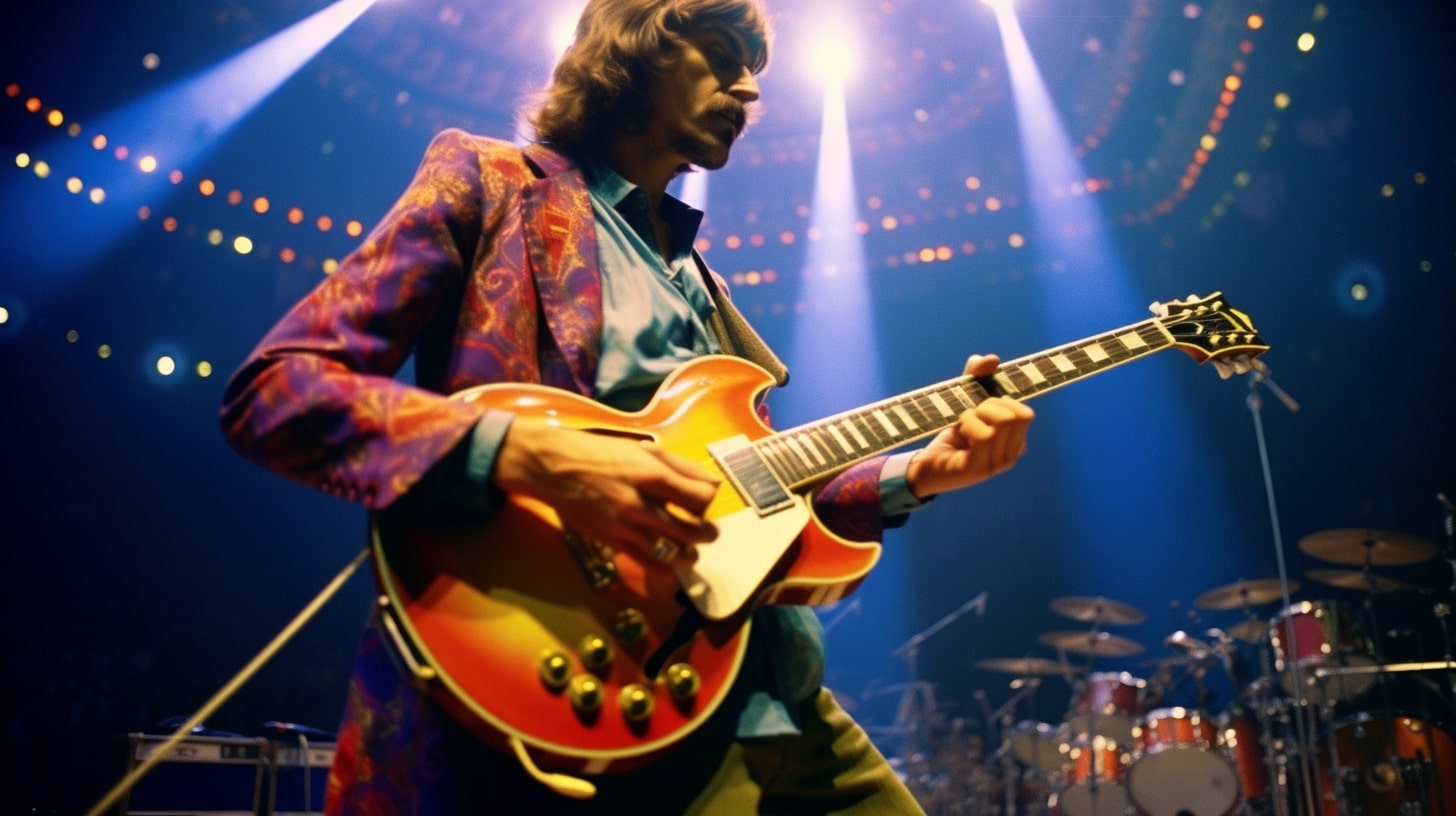George Harrison was a renowned British musician, singer, and songwriter. He rose to fame as the lead guitarist of the Beatles, one of the most influential bands in the history of rock music. Harrison, A self-taught musician, played a pivotal role in shaping the band’s unique sound, often employing unconventional and innovative techniques.
George Harrison stood out as a creative, experimental musician throughout his career. His proficiency in various instruments and willingness to experiment with different musical styles left an indelible mark on the world of rock music.
Contents
George Harrison and the Beatles
Rise to Fame
George Harrison, born on February 25, 1943, in Liverpool, England, was the youngest of Harold and Louise French Harrison’s four children. He became the lead guitarist for the iconic English rock band The Beatles, a group that played a significant role in the evolution of both pop and rock music.
During their early years, The Beatles developed their style and experimented with various musical genres. George Harrison’s musical talents and unique guitar skills became evident as the band grew and evolved. His contributions to the group helped shape their signature sound and cemented their status as one of the most influential bands in music history.
Role in the Band
In The Beatles, George Harrison played various guitars, including the Gibson J-160E, an acoustic guitar with an electric pickup at the base of the fretboard. Apart from playing the guitar, Harrison became known for introducing the sitar, an Indian stringed instrument, to the band. In 1965, he studied the sitar with Ravi Shankar and first featured his sitar skills in “Norwegian Wood” (1965).
Harrison contributed as a songwriter and wrote some of the Beatles’ finest songs, such as “While My Guitar Gently Weeps” (1968), “Here Comes the Sun” (1969), and “Something” (1969). Harrison’s importance as a composer within the band became more apparent with these contributions, elevating him to the level of his bandmates, John Lennon and Paul McCartney. He also harbored a deep love for the ukulele and incorporated its sound into some of their music.
Throughout his time with The Beatles, George Harrison showcased his immense talent as both a guitarist and a composer. His skillful blending of guitar styles and mastery of various instruments, such as the sitar and ukulele, was instrumental in shaping the unique sound and style of the band, thereby influencing the entire genre of pop and rock music.
Essential Guitars
Acoustic Guitars
One of George Harrison’s acoustic guitars was the Gibson J-160E. This acoustic/electric guitar was well-known for its use during his time with the Beatles. The Gibson J-200 also found its way into Harrison’s collection and was notably used by Bob Dylan during a performance at the Isle of Wight in 1969.
Electric Guitars
George Harrison played a variety of electric guitars throughout his career. Some of the most iconic models include:
- Gretsch Duo Jet: Harrison’s first good guitar, a 1957 model he acquired in 1961. This guitar played an important role in shaping his early sound.
- Gretsch Country Gentleman: A walnut-finished guitar that Harrison used during his early days with the Beatles.
- Gretsch Tennessean: Another Gretsch model Harrison often played during his time in the band.
- Rickenbacker 360/12: This electric twelve-string guitar became famous during the 1960s partly due to Harrison’s usage. Alongside the Rickenbacker 360/12, he also used the Rickenbacker 425 and the Rickenbacker 325.
- Fender Stratocaster: The “Rocky” 1961 model was a long-time dream of Harrison’s that he acquired in the early ’60s. This model became a staple in his collection.
- Fender Telecaster: Harrison made a rosewood version of this guitar famous during his time with the Beatles.
Bass Guitars
Although George Harrison was primarily known for his work on guitars, he occasionally played bass as well. In doing so, he used a variety of bass guitar models, such as:
- Rickenbacker 4001: Harrison played this bass guitar occasionally during his time with the Beatles. It could be seen in the documentary “Let It Be.”
- Fender Jazz Bass: This model was also found in Harrison’s collection, although it was not his primary instrument.
Overall, George Harrison’s diverse range of guitars and bass guitars played a crucial role in shaping his style and sound, contributing to his legacy as a rock-and-roll legend.
Playing Techniques
Slide Guitar
George Harrison’s playing techniques were diverse and innovative. One of his signature guitar styles was the slide guitar. He developed a distinct, melodic approach to playing slides, often using open tunings and combining elements of Indian music and traditional blues. His expressive slide-playing can be heard in songs like “My Sweet Lord” and “Isn’t It a Pity.”
Rhythm Guitar
As a rhythm guitarist, Harrison demonstrated a great sense of timing and dynamics. He was able to play intricate chord structures and fingerpicking patterns, complementing the music of The Beatles and his solo work.
One example of his rhythmic prowess is in the syncopated rhythm pattern in “Here Comes the Sun.” George’s rhythm guitar playing was an essential element in their sound, laying a solid foundation for the other instruments.
Guitar Sounds and Effects
Beyond slide and rhythm guitar, George Harrison experimented with various guitar sounds and effects to create a unique sonic palette. He was among the first guitarists to use a volume pedal, which enabled him to create ethereal, swelling sounds, as heard in “I Need You.” He also used fuzz and distortion effects to create crunchy, powerful tones on songs like “Revolution” and “Hey Bulldog.”
George’s innovative approach to guitar sounds also included exploring new guitar models. For instance, he played a 1964 Gibson SG Standard which offered a unique tone and contributed to his distinctive sound. In other instances, he used a Fender Stratocaster and a Gibson J-200 acoustic guitar to further diversify his tonal palette.
Notable Performances and Albums
Help!
George Harrison, the lead guitarist of the Beatles, contributed greatly to the band’s 1965 album, Help! In particular, he showcased his skill on the 12-string Rickenbacker guitar in the song “Ticket to Ride.” His distinctive guitar sound on this track became a signature part of the Beatles’ sound during this period.
Rubber Soul
In 1965, the Beatles released their sixth studio album, Rubber Soul. George Harrison played an important role in the album’s creation with his unique guitar techniques and influences from Indian music. Standout tracks where Harrison’s guitar playing is prominently featured include “Norwegian Wood (This Bird Has Flown)” and “Nowhere Man.” His experimentation with the sitar on “Norwegian Wood” marked the first use of this instrument in a Western popular music context and, in part, played a role in popularizing Indian music in the West.
Revolver Album
The 1966 Revolver album saw George Harrison further expanding his musical horizons, showcasing his versatility as a guitarist. One of the most notable tracks on this album is “Taxman,” which features a fast-paced, biting guitar riff that reflects Harrison’s growth as a musician.
Another significant track is “Love You To,” where he continued to explore Indian musical styles by incorporating the sitar, tabla, and tambura. This increased incorporation of Indian music further solidified Harrison’s reputation as an innovative and influential guitarist.
Influences and Impact
Musicians Who Influenced Harrison
Carl Perkins was one of the most significant influences on George Harrison’s musical style. Harrison remained a lifelong fan of the American rockabilly musician, whose playing significantly shaped Harrison’s early work with The Beatles, particularly on songs like “All My Loving” and “Eight Days a Week.”
Another major influence on Harrison was Chuck Berry, a pioneering rock and roll musician known for his guitar riffs, showmanship, and strong vocals. Berry’s distinctive guitar sound and innovative approach to songwriting had a lasting impact on Harrison’s musical development.
Harrison’s Influence on Others
George Harrison’s guitar work and songwriting played a crucial role in shaping The Beatles’ sound and consequently had a significant impact on the broader music world. The way he incorporated various techniques, such as the use of a Fender Stratocaster for his solo recordings and a Gibson J-200 acoustic guitar on the classic track “Something,” left a lasting impression on fellow musicians.
Apart from his guitar work, Harrison introduced the traditional Indian instrument, the sitar, to The Beatles’ music after being taught by the legendary Indian musician Ravi Shankar. This led to an increased global interest in Indian music and culture, further expanding the band’s sonic palette.
Overall, George Harrison’s influence extended beyond The Beatles and contributed to the success of numerous musicians who followed in their footsteps. His innovative guitar techniques, songwriting prowess, and openness to incorporating different musical styles and traditions will forever be remembered for their impact on the evolution of rock music in the 20th century.
Harrison’s Personal Guitars
Rocky
One of George Harrison’s most iconic guitars was his 1961 Fender Stratocaster, known as “Rocky.” Initially, this guitar featured a Sonic Blue finish. However, Harrison later customized it with a unique hand-painted design, transforming it into the visually striking instrument that fans recognize today. He used Rocky throughout his career, both with The Beatles and during his solo work.
Sonic Blue
Before his famous custom paint job, Harrison’s 1961 Fender Stratocaster, Rocky, was originally known for its Sonic Blue finish. Highly sought after, this guitar became a staple of Harrison’s performances and recordings with The Beatles.
The Sonic Blue finish was a common feature among Fender Stratocasters of that era, and Harrison’s choice of this beautiful guitar helped establish it as a classic instrument.
Customized Guitars
In addition to Rocky, George Harrison played a variety of other guitars with unique finishes or customizations. Some notable examples include:
- Gretsch 6131 Jet Fire Bird: A distinctive guitar with a walnut finish, which was quite bulky and notable for its appearance during Harrison’s early days.
- Maton Mastersound MS-500: Harrison used this guitar in 1963, acquiring it from Sound City London, and it appeared on various Beatles recordings, such as “She Loves You” and the With The Beatles album.
- Resonet Futurama: At a time when Fender Stratocasters were hard to find, Harrison acquired a similarly-structured Futurama guitar as a step up from his previous Hofner Club 40.
- Hofner President F-Hole Acoustic: Purchased in 1958, Harrison played this guitar during the early stages of his career, even using it at his brother Harry’s wedding reception.
Throughout his musical journey, George Harrison became known for his diverse selection of guitars and their unique finishes or customizations. From the iconic sunburst finishes to the intricately painted and modified instruments, Harrison’s personal guitars are symbols of his lasting influence and emphasize his innovative and creative spirit.
Equipment and Gear
Amplifiers
George Harrison, primarily known as a guitarist for The Beatles, utilized a variety of amplifiers throughout his career. One of the most notable amplifiers Harrison often played was the Vox amp. These amps played a significant role in creating the distinct sound of The Beatles during their early days.
Aside from Vox amps, Harrison also explored other brands as his career progressed. This exploration enabled him to deliver a wide range of tones, demonstrating the versatility of his musicianship.
Pedals and Effects
Harrison’s effects setup was relatively minimal compared to some other guitarists of his time and later, yet the effects he used still had an impressive impact on his sound. Some of the key components in Harrison’s gear setup included:
- Fuzz: Harrison used fuzz effects to create a thicker, more distorted tone that marked many of the Beatles’ classic tracks and his solo work.
- Wah: The wah-wah pedal was a significant part of Harrison’s sound, allowing for dynamic expression and enhancing his melodic approach to soloing.
Throughout his career, George Harrison’s choice of gear and technology played a crucial role in his artistic development as a musician. By leveraging his equipment, Harrison was able to shape his signature sound, leaving a lasting impact on the music industry.
Legacy and Recognition
George Harrison achieved international fame as the lead guitarist of The Beatles, one of the most important and influential bands in the history of rock music. Harrison played various instruments throughout his career, but he is best known for his proficiency on the guitar.
Rolling Stone magazine ranked him number 11 in their list of the 100 Greatest Guitarists of All Time. His innovative techniques, such as using unconventional instruments and incorporating Eastern music elements, significantly contributed to The Beatles’ unique sound.
Harrison’s music continues to be widely celebrated and appreciated in the United States and the UK. Besides the guitar, he also played the sitar, four-string guitar, bass guitar, arp bass, violin, tamboura, dobro, swordmandel, tabla, organ, piano, Moog synthesizer, harmonica, autoharp, glockenspiel, vibraphone, xylophone, and claves.
His versatility contributed to The Beatles’ success and paved the way for his solo career, including the notable album All Things Must Pass. On this album, he played the Gibson J-200 acoustic guitar, an instrument held particularly dear to him.
As part of The Beatles, George Harrison was inducted into the Rock and Roll Hall of Fame in 1988, solidifying the band’s place in rock history. He received this prestigious honor again in 2004 as a solo artist, making him a two-time inductee. Harrison’s passion and dedication to his craft have left a lasting impact on the music industry, inspiring generations of musicians who followed in his footsteps.
Throughout his career, George Harrison was widely recognized for his immense talent and contribution to rock music. Today, his musical legacy lives on, with both fans and fellow musicians alike continuing to pay tribute to the legendary guitarist, singer, and songwriter from Liverpool.






